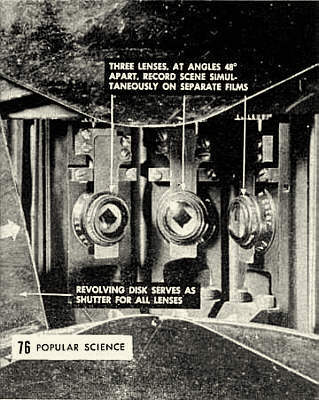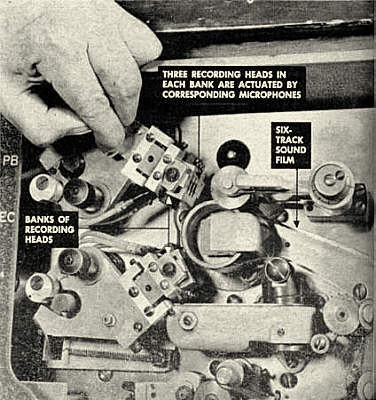Super-Movies
Put You
In the Show
PS takes you behind the scenes where an exciting new technique of film-making is being groomed for its public debut.
By Alden P. Armagnac
PS PHOTOS BY HUBERT LUCKETT
| 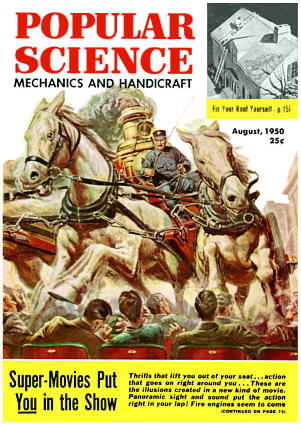 |
THRILLS that lift you out of your seat . . . action that goes on right around you . . . these are the illusions created in a new kind of movie.
Panoramic sight and sound put the action right in your lap. Fire engines seem to come right at you. Planes roar over your head. You're not just looking at this "wraparound" movie show - you're in it!
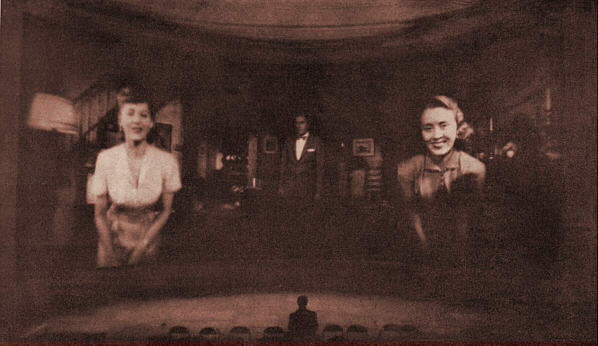 |
Spectator gets striking impression he's right in room he sees on big curved screen above. Here inventor Fred Waller and two girl assistants appear in Cinerama film introducing super-movies at preview in East Norwich, N.Y., demonstration theater. Pictorial diagram below shows how process transfers action from reality to screen, with aid of three-lens camera and theater system of three projectors. |
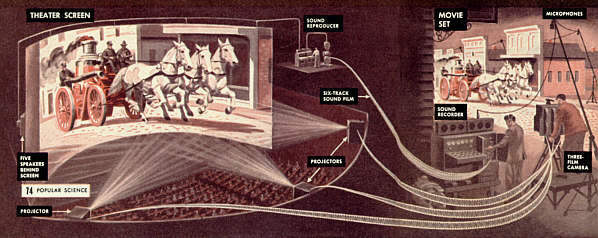 |
Super-movies produced by the new system, known as Cinerama, may make their public debut late this year or early in 1951. Previews of short Cinerama films have been given movie makers and exhibitors at an East Norwich, N. Y., indoor tennis court converted into a demonstration theater. Negotiations are in progress to make the first full-length super-movies and equip theaters to show them.
So powerful is Cinerama's feeling of reality that when one preview "short" portrayed a ride on an amusement-park roller coaster several spectators became seasick and had to leave hastily. (This reporter stuck it out, hanging on tight to both chair arms.) Super-movies attain this realism by a new departure in methods.
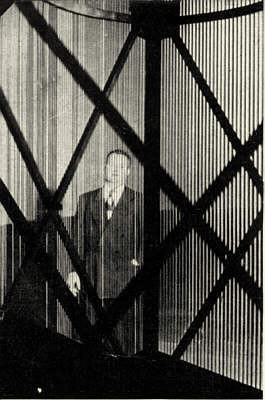 |
CURVED SCREEN has end sections of vertical ribbons, arranged like slats of Venetian blind. This eliminates reflection of light from ends to center of concave screen, which detracted from clarity of picture there when ordinary screen material was used. |
First, they are not, nor do they claim to be, stereoscopic or three-dimensional movies. Those require either a special screen that only a limited portion of a normal audience can view from just the right angle, or special spectacles for all viewers, which most movie patrons simply won't be bothered with. No such gadgets are used by Cinerama audiences.
Actually, only a part of the clues that make a scene seem real to you are supplied by binocular, or two-eyed, vision. By skillfully combining others, the Cinerama process gives substantially the same effect.
Just as in real life, you can look all around, as well as straight ahead. Cinerama's big "wrap-around" screen of eight times the standard size-twice as high, and four times as wide-forms a great curving arc across your field of view. It seems to surround you with action taking place on it. That gives you the feeling of being right in the midst of things-instead of outside, looking in.
People in close-ups, on this giant screen, fill your vision. They seem so near that you could reach right out and touch them.
Your impression of seeing the scene through your own eyes, instead of the camera's, is heightened by picture-taking lenses that match the human eye in focal length and give exactly the same perspective.
As convincing to your ears as to your eyes is the simulation of reality. Wherever an actor may be on the screen, that is where you hear his voice coming from. From behind you, you first hear the voices of a procession of singers, as they march onto the scene from behind the camera.
Filming and projecting a scene of Cinerama dimensions is no small feat. Almost literally eyefilling, the picture covers a field of vision about 146° wide and 55 1/2° high-not far from the extreme limit, 160° by 75°, of human eyes. No single lens, not even a wide-angle one, can satisfactorily take in more than a fraction of this territory.
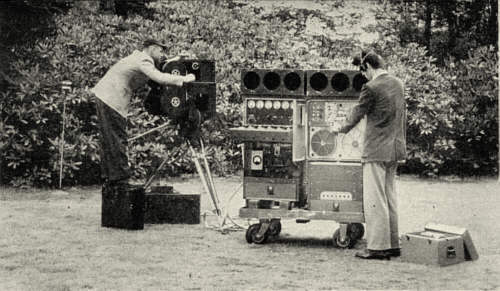 |
FIELD EQUIPMENT for making super-movies, above, consists of Cinerama camera and portable sound-recording outfit. Latter uses six standard microphones spotted at strategic locations. |
So the 150-pound Cinerama camera consists of three cameras in one. Its eyes are three matched lenses, of 27-mm. focal length, set at angles 48° apart. Each lens records one-third of the total width of the scene, upon one of three standard 35-mm. films carried in as many film magazines. Otherwise. the three sections operate as one. Lines of sight of the three lenses converge and cross at a point 11/16 of all inch in front of them, where a single revolving-disk shutter serves them all, assuring synchronization of exposures. One knob simultaneously focuses all three lenses. Another knob controls diaphragm settings in unison.
Individual Cinerama frames are half again standard height. Since three strips are used, the total amount of picture film used is 4 1/2 times as much as lor a standard movie.
After the camera has dissected the scene into three parts, it remains for the theater's projection system to put the parts together again. This requires three projection booths instead of the customary single one. Installation of these booths and of the large curved screen will adapt existing theaters to show Cinerama films.
Projectors' Angles Match Cameras'
From angles like those of the camera lenses, the theater projectors throw the three sections of the picture side by side oil the screen. The center section of the screen is curved, usually on a 25-foot radius, and two flat wings are tangential to this curve. The depth of focus of the projecting lenses is great enough so that the curvature of the screen presents no problem.
An innovation in each projector is a mechanical device nicknamed a "gigolo," because it jiggles up and down. Just as a photographer makes a vignette, this mask with a saw-tooth edge moves along the border of a film, so that the picture
gradually fades from view at its edge.. Thus adjoining films blend together on the screen without a conspicuous dividing line.
For realistic sound effects, six microphones in the field make individual tracks on a single 35-mm. sound film used for this purpose alone. Theater speakers, arranged in the same pattern as the microphones, are individually operated by the sound
tracks. This produces the striking "sound-perspective" illusion that makes voices and music come from the right directions. A favored technique places five microphones and speakers, respectively, in a row across the full width of the movie set and the theater screen. The sixth microphone is put some distance behind the camera and picks up offstage" sounds, reproduced in the theater by a speaker at the rear of the audience.
Recent strides in magnetic recording have led to the choice of magnetic-type sound film, which needs no laboratory processing and call be played back at once.
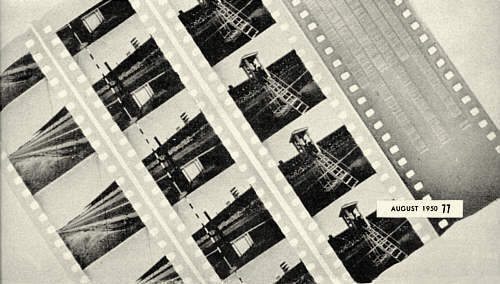 |
PUT THESE FOUR FILMS TOGETHER and you have a Cinerama movie. First three form left-hand, center, and right-hand parts of picture, when projected side by side on theater screen. Dark film at right carries six sound tracks that operate theater's speakers. Picture frames are half again standard height. To make them, camera advances standard 35-mm. film six perforations at a time, instead of the usual four. Magnetic-type 35mm. sound film, with opaque coating of iron oxide, needs no laboratory processing and it can be played back immediately. |
Like conventional movies in their infancy, the preview films are not entirely free of technical faults; for example, straight lines are distorted by certain camera angles, which must be avoided. As the sponsors point out, these are experimental films, which will be bettered as the possibilities and limitations of the novel technique are more fully explored.
Super-movies are the invention of Fred Waller, former Paramount Pictures executive, and designer of the Waller Gunnery Trainer (PS, Sept., '43, p. 65). His experiments with Cinerama began in 1938, War interrupted its development for entertainment, but it was incorporated in Waller's trainer. This used a five-lens camera and five projectors to portray airplanes realistically on a curved screen as Air Force practice targets. Since the war, he has developed the simpler three-lens process.
Will theaters adopt super-movies to offer their patrons new thrills in entertainment? Facing the growing competition of television, the movie industry has been seeking a way to meet the challenge. Cinerama's sponsors believe they have the answer.
END
Copyright © 1950 - Popular Science Magazine
Transcription & HTML version; Copyright © 1999 The American WideScreen Museum
Back to the Time Machine
Back to the Lobby




